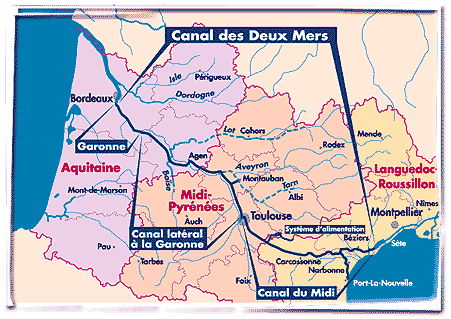| |
The Canal des Deux Mers is the result of an early example of regional
planning on a grand scale, backed up by strategic military interest,
since the kings of France, from Henri IV onwards, dreamed of this
inland waterway and the impact it would have in political terms.
Trade between the Atlantic and the Mediterranean would thus be
saved the perilous detour via Gibraltar.
It is Pierre Paul Riquet, Baron of Bonrepos, who turned the dream
into reality. He was the visionary entrepreneur who devoted the
last 20 years of his life to the mammoth task of building the
Canal du Midi (240 km, from Toulouse to the Bassin de Thau, and
101 locks). Born in Béziers (Languedoc-Roussillon) in 1604,
Riquet lived for many years close to Toulouse at Verfeil, and
it is from here that he managed the works between 1662 and his
death in 1680. Just seven months later, the canal was opened to
the first freight barges, soon followed by packet boats which
also carried paying passengers.

It is thus more than three centuries of waterway operation for
the benefit of regional development which were recently celebrated,
when UNESCO gave the Canal du Midi the prestigious World Heritage
label. "Canal des Deux Mers" is the name now commonly
used for the entire navigable route which extends for nearly 500km
from Bordeaux to Sète.
Hundreds of thousands of people visit the waterway each year.
It has the effect of increasing their period of stay in the area,
and has even brought about a change in holiday habits, compared
to the traditional migrations towards the sea or the Iberian peninsula.
The canal encourages the visitor to linger, to discover extremely
varied localities and landscapes. It has become an essential factor
in development of the local economy in the entire corridor of
the "rivières et Canaux du Midi".

|
|



